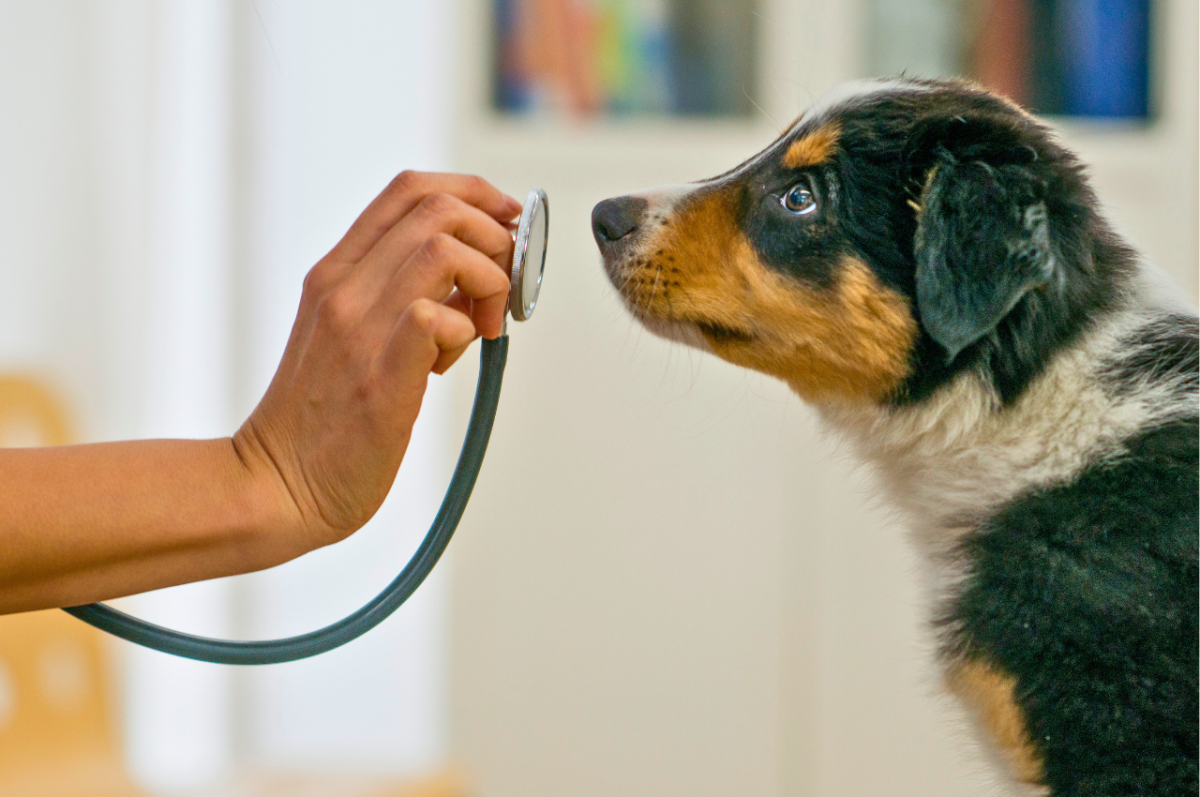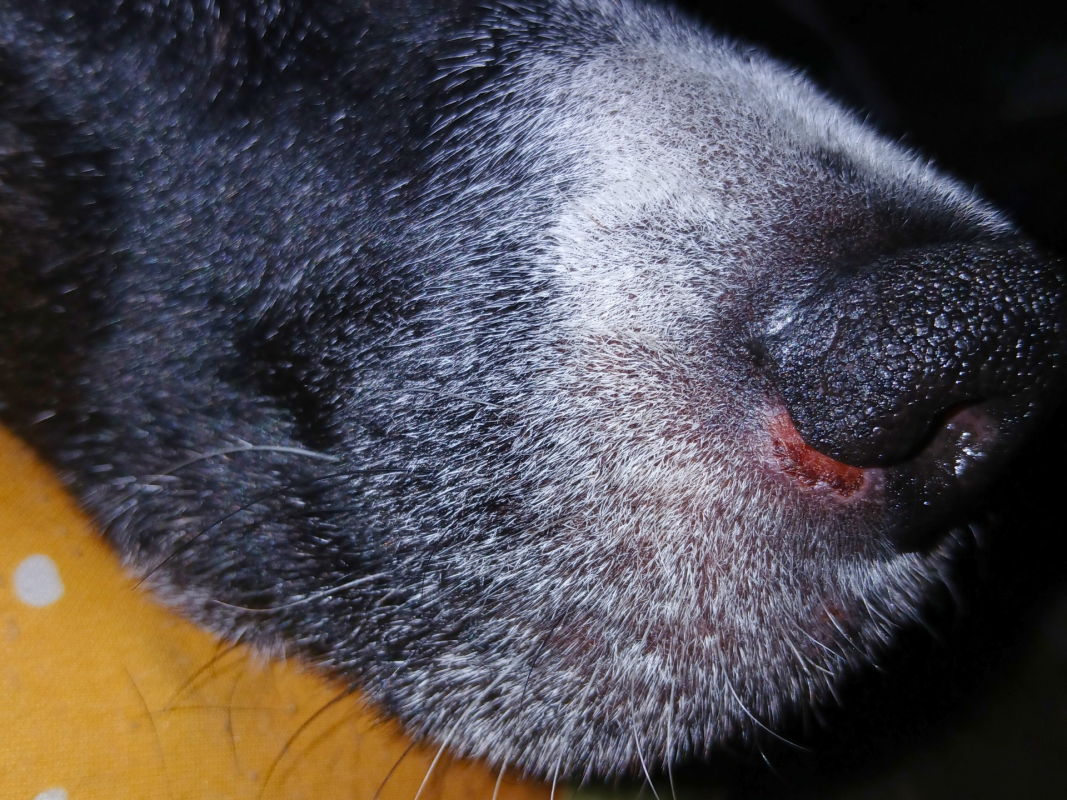Q:
I’ve noticed my dog’s skin turning red and inflamed beneath his snout during wintertime, along with developing scabs around his mouth. Although the scabs near his mouth have now healed, his nose remains quite reddened. I’m unsure whether this might be due to an allergy or some other issue altogether.
A:
Not being able to examine the sores inside the mouth makes it difficult to provide an accurate assessment, but according to the photograph, multiple issues might be responsible for causing those reddish spots on the nose, as detailed below.
Related: What Causes My Dog’s Skin to Turn Red Everywhere?
Possible Reasons for Crusty Noses and Maws in Canines
-
Pyoderma
from dry skin:
This scenario is far more probable if the crusts appear on the lips rather than on the mucous membrane inside the mouth. Additionally, it tends to occur when sores vanish during summertime and recur as soon as conditions become drier in winter. Occasionally, an ensuing infection can cause itching, though this isn’t universal. -
Ringworm:
This is a kind of fungal infection that might impact the muzzle, as seen in the image provided. Typically, it appears on just one side; however, this isn’t always certain. -
Pemphigus:
This condition is an autoimmune disorder that leads to sores on the snout which can resemble the image provided. Although it doesn’t follow a seasonal pattern, these sores might appear and disappear intermittently. -
Leishmania:
This parasitic infection can lead to such lesions appearing in various areas across the body, though they frequently show up on the face as well. -
Rhinitis:
This condition typically involves inflammation of the nasal mucous membranes. The underlying cause could vary, though it’s generally due to either a bacterial or viral infection affecting the nose. Along with the crusts visible in the image, affected dogs often sneeze and might experience additional symptoms.
runny nose
And occasionally experience issues with breathing. -
Sinusitis:
Rather than merely having sores on the nose as seen in rhinitis, this might indicate an infection further inside the dog’s head, within the sinus cavities.
After finishing the examination and assessing the oral condition to identify the probable cause among these options, we should pinpoint it further through either a biopsy of the scab or an analysis of the discharge or a skin scraping to ascertain the type of infection responsible for the symptoms.
Certain dogs might require an examination using an endoscope to determine whether a foreign body in the nasal passage is responsible for these issues.
A fungal infection is among the most frequent culprits, however, if the scabs are solely present on the lips, my primary concern would be dry skin along with a possible secondary infection.

What Steps Should I Take to Determine Which of These Issues Is Resulting in Those Sores?
Sadly, such issues cannot be accurately diagnosed online. To properly identify the problem, you’ll need a physical examination for your pet. If further clarification is required after this initial check-up, then either a biopsy or scraping of the affected area may be necessary for accurate diagnosis.
What Are Your Options If There’s No Vet Available?
If you can’t bring your dog to a vet, consider treating it for pyoderma that has developed due to dry skin.
In case this turns out to be a fungal infection, medication will be necessary. You can take certain steps at home to make him feel better, however, I should stress that these measures will merely provide relief rather than resolve the issue completely.
A few activities you can try at home include:
-
Maintain moisture on the skin around the nose:
Examine the skin beneath the arms and around the base of the tail at the rear. These areas frequently show indications of dryness; if your dog appears affected, consider using a humidifier along with some treatments for relief.
remedies for dry skin
to help moisturize it. -
Ensure you include ample nutrient-dense calories:
When your dog consumes dry food and requires more calories than usual—such as during recovery from an illness—the additional energy can prove beneficial. Simply sticking to their normal diet might not suffice; thus, supplementing with treats like liver or chicken hearts could make a significant difference. -
Maintain the cleanliness of the nose as much as possible:
Should you notice dirt accumulation around your dog’s nostrils upon waking up each morning, or if they have been outdoors digging and soiled this area, gently cleanse it using a damp cloth. -
Apply
coconut oil
:
This oil serves as a natural antibiotic and antifungal agent while also hydrating the skin surrounding your nose. Apply approximately 1 cubic centimeter of this oil onto the scabs near your nostrils two times daily until they disappear. Avoid using it inside your mouth since although it’s non-toxic, it won’t provide moisture there; however, should the scabs return on your lips, applying it there could prove beneficial.
Fingers crossed, this issue might resolve itself over the summer if it’s just due to dry skin. However, should things get worse or if any new spots show up, make sure to reach out to your nearby vet for an examination. They may also suggest doing a biopsy of the crusts to determine what’s going on with your pup.
Best of luck.
Up Next:
Related: Hot Zones Without a Veterinarian? Care for Your Dog at Home
Sources
-
Anderson JG. Oral Lesions in Dogs: A Decision-Tree Approach to Treating Ulcers, Leukoplakia, and Pigmented Lesions. Journal of the American Veterinary Medical Association. 2023 Sept 16;261(S2):S62-S69. doi: 10.2460/javma.23.05.0294. PMID: 37699542.
https://pubmed.ncbi.nlm.nih.gov/37699542/







